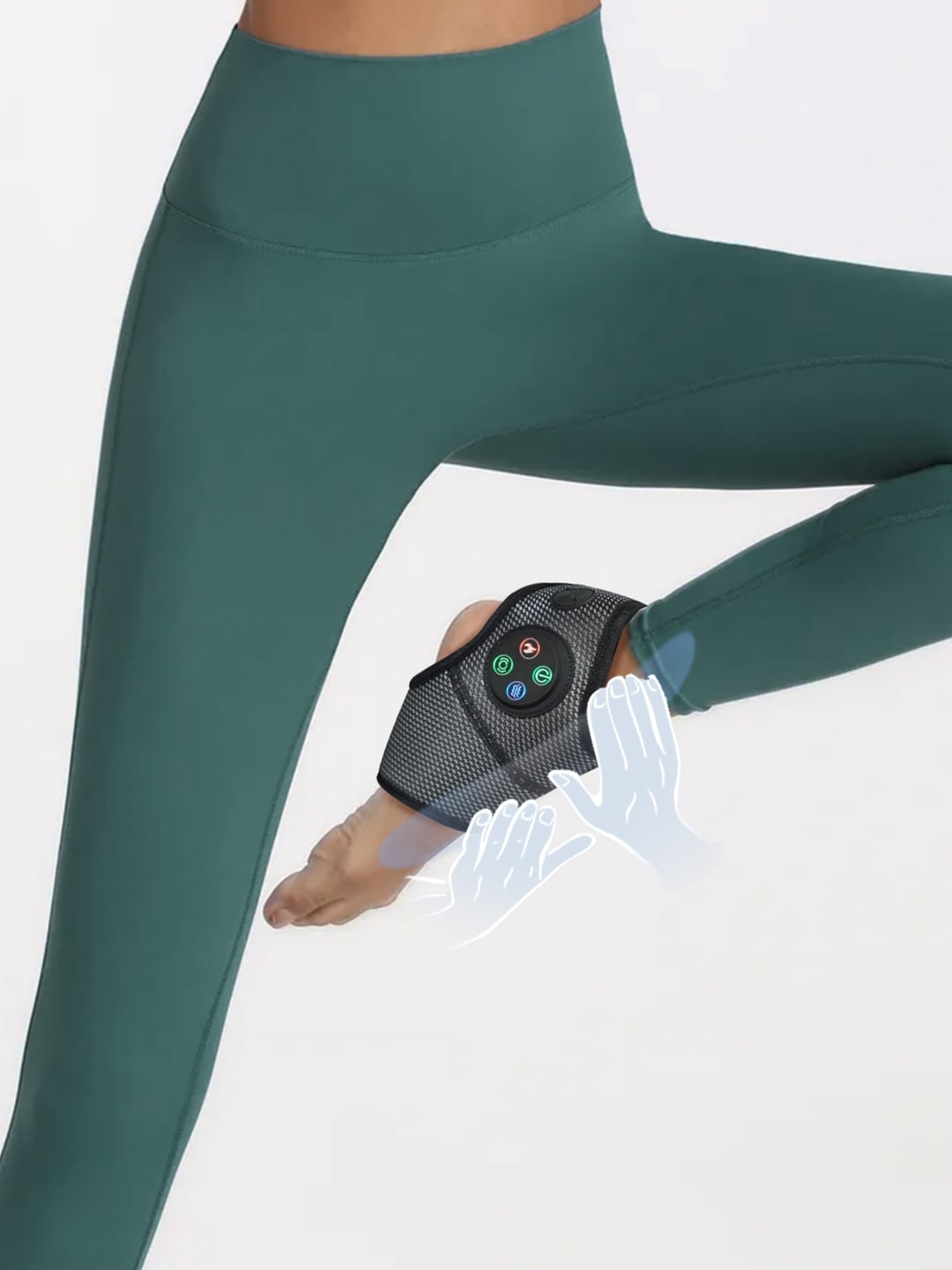Foot Massage for Neuropathy: Is it Safe for Your Parents' Pain?
- By Grace
- Updated on
Have you ever felt that persistent tingling, numbness, or burning sensation in your feet? For many middle-aged and elderly people, these discomforts are hallmarks of neuropathy, a condition affecting the nerves that can profoundly impact daily life. Seeking effective ways to manage foot pain and improve comfort is a common quest.
As someone who has seen the profound difference thoughtful care can make, I believe understanding the nuances of foot massage for neuropathy is crucial. It's not just about applying pressure; it's about a precise, informed approach tailored to individual needs. This article will guide you through safe and effective strategies to find relief, ensuring your approach is as beneficial as it is cautious.
Understanding Neuropathic Foot Pain: What is Neuropathy?
Neuropathy, specifically peripheral neuropathy, refers to damage to the peripheral nerves—those located outside the brain and spinal cord. These nerves are vital for transmitting sensations from the body, controlling muscle movement, and regulating automatic functions like digestion and heart rate. When these delicate nerves, especially those extending into the parts of feet, are compromised, the signals get scrambled or lost entirely, leading to a range of uncomfortable and often debilitating symptoms.
The challenge with neuropathic foot pain is its diverse presentation. While some might experience a dull ache, others report sharp, electrical shooting pains or an unbearable burning sensation. The loss of protective sensation, where you can't feel injuries, is particularly concerning. This complexity means that any approach to care, including foot massage, must be carefully considered to avoid inadvertently causing further harm while genuinely aiming for relief.
- Numbness or Reduced Sensation: A common and dangerous symptom, as it can mask injuries.
- Tingling or "Pins and Needles": Often described as a crawling or prickling sensation.
- Sharp, Shooting, or Burning Pain: Can be intermittent or constant, severely impacting comfort.
- Extreme Sensitivity to Touch: Even light pressure, like from bedsheets, can be agonizing.
- Muscle Weakness: Affecting balance and coordination, increasing fall risk.
Why Addressing Neuropathic Foot Pain Matters: Impact on Quality of Life
Ignoring neuropathic foot pain isn't just about enduring discomfort; it has a profound ripple effect on an individual's overall quality of life, particularly for middle-aged and elderly people. The constant pain can lead to disrupted sleep patterns, which in turn exacerbates fatigue and can worsen pain perception. Mobility is often significantly impaired, making simple daily tasks like walking, standing, or even just shifting position, a monumental challenge. This reduction in activity can spiral into a decline in overall physical health and independence.
Proactive management, however, offers a pathway to significant improvement. By consciously addressing symptoms and exploring appropriate interventions like targeted foot massage, individuals can experience enhanced comfort and better sleep. Improved mobility allows for greater engagement in daily activities and social interactions, fostering a sense of independence and well-being. Focusing on the potential benefits of massaging feet carefully can genuinely transform daily living from a struggle to a more manageable experience.
- Difficulty walking and balancing, leading to instability.
- Increased risk of falls and injuries due to impaired sensation.
- Disrupted sleep patterns, causing fatigue and irritability.
- Reduced ability to engage in physical activities or hobbies.
- Emotional distress, anxiety, and decreased independence.
Navigating Foot Massage Tools: Approaches for Different Neuropathy Severities
Given the complexity of neuropathy, choosing the right foot massage approach is paramount. It’s not a one-size-fits-all solution; what works for one person might be too intense or even harmful for another. My experience suggests that a nuanced understanding of tool suitability, especially for sensitive feet, is what really, really makes a difference.
For Mild Symptoms: Exploring Modern Foot Massagers
For individuals with mild neuropathic symptoms and intact protective sensation, certain modern foot massagers can offer noticeable relief. Devices incorporating heating, vibration, compression, or red light therapy are designed to improve blood circulation, relax tense muscles, and provide sensory stimulation. The warmth can be deeply soothing, while gentle vibration might help stimulate nerve endings and compression could reduce localized swelling, contributing to the overall benefits of massaging feet.
When considering these tools, I always advise starting with the lowest possible settings for both intensity and heat. It's crucial to use them for short durations, perhaps 5-10 minutes initially, and to check your skin regularly for any signs of redness, irritation, or blistering. Look for models that offer precise control over intensity and temperature, allowing you to gradually adjust to a level that provides comfort without causing distress.
- Start Gentle: Always begin with the lowest intensity and shortest duration.
- Monitor Skin: Regularly inspect the parts of feet for redness or signs of irritation.
- Choose Wisely: Opt for massagers with variable settings for heat, vibration, and compression.
- Enhance Circulation: These tools primarily work by promoting blood circulation, aiding nerve health.
For Moderate to Severe Neuropathy: The Cautionary Approach
For patients experiencing moderate to severe neuropathy, especially those with significant loss of sensation, the use of mechanical foot massagers should be approached with extreme caution, and often, it's better to err on the side of avoiding them altogether. Impaired sensation means an individual might not perceive excessive pressure, friction, or heat, leading to serious skin breakdown, ulcers, or even further nerve damage. Mechanical devices, while seemingly benign, can be surprisingly aggressive on compromised tissues.
Crucial Warning: If sensation is severely impaired, mechanical devices can pose significant risks. They might apply pressure to sensitive foot pressure points without the user feeling it, potentially causing harm. This is simply too great a risk when protective feedback mechanisms are absent. Always consult a healthcare professional before considering such devices.
If, under rare and very specific medical guidance, a mechanical device is deemed acceptable, meticulous skin checks before and after each use are non-negotiable. The user or a caregiver must diligently inspect the entire foot, including between the toes and the soles, for any signs of injury. My insights from years of practice strongly suggest that for these cases, manual or non-mechanical methods offer a far safer pathway to potential relief.
Safe & Soothing Alternatives: Non-Mechanical Options
When dealing with sensitive or severely affected feet, non-mechanical options truly shine as safe and deeply soothing alternatives. A warm foot bath, for instance, can relax muscles and improve circulation. The key here is "warm," not hot—always test the water temperature with an elbow or thermometer to ensure it's comfortably lukewarm (around 92-98°F or 33-37°C) to prevent burns when sensation is diminished. This simple act offers a gateway to the broader benefits of massaging feet through relaxation.
Gentle stretching exercises for the ankles and toes can maintain flexibility and promote blood flow without direct mechanical stress. Manual foot massage, performed by a trained caregiver or gently by oneself, is often the safest and most effective method. It allows for direct feedback, precise control over pressure, and immediate adjustment if discomfort arises. Focusing on very light, rhythmic strokes, particularly around the acupressure points on feet (such as Kidney 1 on the sole, or Liver 3 between the first two toes, always with light pressure), can be incredibly therapeutic. This personalized touch simply cannot be replicated by a machine.
- Warm (Not Hot) Baths: Use lukewarm water to relax muscles and improve blood flow.
- Gentle Stretching: Incorporate light ankle rotations and toe wiggles to maintain flexibility.
- Manual Massage: Utilize gentle, rhythmic strokes with moisturizing lotion for direct feedback.
- Acupressure Points: Lightly stimulate acupressure points on feet, always within comfort limits.
- Moisture and Inspection: Keep feet moisturized and check for any skin changes daily.
Holistic Tips for Managing Neuropathic Foot Pain: Beyond the Massager
While targeted foot massage can be a valuable component of managing neuropathic discomfort, it's crucial to understand that it's part of a broader, holistic approach. The very first step should always be a consultation with a healthcare professional. They can accurately diagnose the type and severity of your neuropathy, identify underlying causes, and provide a comprehensive treatment plan that considers all aspects of your health. Keeping a detailed foot pain chart, noting the type, intensity, and triggers of your discomfort, can be incredibly useful for these discussions, providing clear data for your doctor.
Beyond professional medical guidance, lifestyle management plays a pivotal role. For individuals with diabetic neuropathy, maintaining stable blood sugar levels is paramount, as this directly impacts nerve health. Regular, gentle exercise, such as walking or swimming, can improve circulation and nerve function. Furthermore, proper footwear—well-cushioned shoes with a wide toe box—is essential to prevent pressure points and potential injuries to the vulnerable parts of feet. Integrating these practices offers long-term benefits that complement any specific massage techniques.
- Regular medical check-ups and nerve health assessments are vital.
- Daily foot care and diligent inspection for any cuts, sores, or changes in skin color.
- Maintaining stable blood sugar levels (if diabetic) to prevent nerve damage progression.
- Wearing protective, well-fitting footwear that cushions and supports the feet.
- Engaging in gentle, supervised physical therapy or stretching routines to improve flexibility.
When to Consult a Professional for Neuropathic Foot Pain
While self-care strategies, including appropriate foot massage, can provide significant relief and improve comfort, they are complementary to, not a replacement for, professional medical advice. It's essential for individuals, particularly middle-aged and elderly people, to recognize when their symptoms warrant immediate attention from a doctor or specialist. Delaying professional evaluation can lead to worsening conditions or complications, especially when dealing with the delicate nature of nerve damage.
If you experience any new or escalating symptoms, it’s a clear signal to seek expert help. Signs of infection, such as increased redness, warmth, swelling, or pus around a sore on the parts of feet, demand immediate medical intervention. Similarly, if your pain becomes unmanageable, begins to interfere significantly with sleep, or if you notice any new weakness or changes in sensation, it’s imperative to consult your doctor. A timely consultation can prevent minor issues from becoming severe and ensure you receive the most appropriate care for your neuropathic foot pain.
- Sudden increase in foot pain or new areas of numbness.
- Development of new weakness in the feet or ankles, impacting mobility.
- Any open sores, blisters, or signs of infection (redness, warmth, pus) on the feet.
- Significant changes in skin color or temperature on the parts of feet.
- Pain that consistently interferes with sleep or daily activities despite self-care efforts.
Managing neuropathic foot pain requires a thoughtful, tailored approach, balancing the potential of modern tools with the inherent safety and intuition of traditional, gentle methods. Whether you're exploring the specific benefits of massaging feet with a cautious mechanical device or embracing the soothing simplicity of a warm bath and gentle hand massage, the key lies in making informed choices that prioritize safety and comfort.
Based on my experience, empowering patients with knowledge about their condition and the right tools—whether it’s a gentle manual touch focusing on acupressure points on feet or an intelligently designed massager simulating traditional techniques tailored for specific needs—is fundamental to managing neuropathic foot pain. Embrace a holistic perspective, stay vigilant with your foot care, and always consult your healthcare provider to ensure your journey towards relief is both effective and safe.
This reply is generated based on currently verifiable public information. It is recommended to cross-check key content with authoritative sources.






